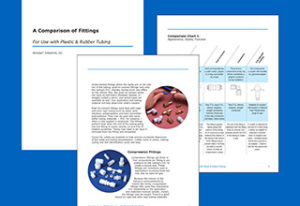 NewAge Industries has announced the release of “A Comparison of Fittings,” a report that looks at several common fittings styles for thermoplastic and thermoset tubing. The paper explains each fitting’s features, applications, material availability, installation steps, and the tubing materials with which each works best. Clamps are also reviewed.
NewAge Industries has announced the release of “A Comparison of Fittings,” a report that looks at several common fittings styles for thermoplastic and thermoset tubing. The paper explains each fitting’s features, applications, material availability, installation steps, and the tubing materials with which each works best. Clamps are also reviewed.
“A Comparison of Fittings” focuses on barbed fittings, push-to-connect fittings, compression fittings and cam operated couplings. It details how each works with tubing to ensure a good seal for proper fluid or air transfer. For instance, the report’s Barbed Fittings section notes that in order to obtain a proper seal, the O.D. (outer diameter) of the barbed area on the fitting must be slightly larger than the I.D. (inner diameter) of the tubing. The Push-To-Connect Fittings section offers tips such as making sure that the tubing used does not have exterior scratches, as this could compromise the seal.
Each section lists the tubing material that works best with each particular fitting. Semi-rigid tubing like nylon, polyethylene and hard durometer polyurethane works well with push-to-connect fittings. Reinforced hose, whether it’s PVC, polyurethane or a multi-layered product, are more often used with cam operated couplings. Softer tubing such as silicone and PVC are well suited for barbed fittings.
Three types of clamps—Oetiker, worm gear and double bond—are examined as well. The paper explains how they’re installed, available materials and considerations for overall fluid system design.
An easy-to-read chart completes the report. It illustrates each fitting’s appearance, describes the styles available (tee’s, wye’s, elbows, etc.), notes whether tools are needed for installation and, if so, what those tools are, and offers application tips.
Note: “A Comparison of Fittings” focuses on fittings, clamps and tubing available from NewAge Industries, Inc.
For a copy of the white paper, visit https://www.newageindustries.com/whitepaper-request.asp; no lengthy registration is required.
The post NewAge Industries publishes white paper that compares fittings appeared first on Hose Assembly Tips.
Filed Under: Fittings, Couplings & Adapters, Hose Assembly Tips